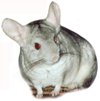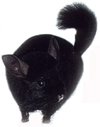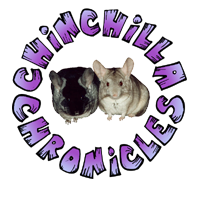 Wild chinchillas all commonly have a colour mutation ranging from grey - brown. This helped camouflage a chinchilla more easily amongst the rocks and stones of the mountains and made them harder to see by predators.
Wild chinchillas all commonly have a colour mutation ranging from grey - brown. This helped camouflage a chinchilla more easily amongst the rocks and stones of the mountains and made them harder to see by predators.
Since the 1950's more colour mutations have evolved with the first appearing in 1955. This first colour mutation, a male exposing the White gene, was produced from two Standard Grey chinchillas and recorded as 44R-B17 (44R=ranch code, B=year designation for 1955, 17=litter number).
Today there are many different colour mutations available all of which stem from the Standard Grey. Some chinchillas show a solid colour and others can be more patchy with various colour's running through the fur.
There are 8 base colours that other colour mutations derive from:
- Standard Grey
- White
- Heterozygous Beige
- Homozygous Beige
- Violet
- Sapphire
- Charcoal
- Ebony
Colour mutations are based on the Standard Grey chinchilla and are known to be either more 'Dominant' or 'Recessive' to the Standard Grey. This is further discussed in the Genetics Section but for the purposes of this segment these colour mutations can be categorized as:
- Dominant Mutation Colour - White, Homo Beige & Black Velvet (known as TOV - Touch of Velvet).
- Recessive Mutation Colour - Hetero Beige, Violet, Sapphire, Charcoal & Ebony.
There are also colour mutations known as 'Carriers', which generally look like another colour mutation but have a 'hidden' gene that will produce babies (kits) of whatever colour is being carried when bred to another chinchilla or 'carrier' of the same 'hidden colour mutation'.
The name 'Wrap' is another term connected to a chinchilla of any colour mutation, which also carries the Ebony gene. This colour influence extends beneath the underbelly where the fur will not be White  as it usually is.
as it usually is.
Standard Grey - The original colour mutation of the wild chinchilla and from which all other colour mutations have been produced. A Standard Grey mutation has a coat of dark grey down the spine and sides and a bright white underbelly.
A hair from a Standard Grey chinchilla has three colours - the base is blue-grey, the  mid-section is a white bar, which extends up to a black tip.
mid-section is a white bar, which extends up to a black tip.
White - As mentioned previously, White was the first colour to show itself as a Mosaic in 1955, since then there are many different colour mutations where White has influence within the fur. Wilson White, Silver and White Mosaic are the most common but there are many others - Black/White Cross, Ebony White, White Violet, White Sapphire, Pink White and Golden Mosaic. White chinchillas can have either  black or ruby eyes depending on the colour mutation produced. White is not an actual colour but is expressed as white due to colour pigmentation not catching on a particular part of the fur.
black or ruby eyes depending on the colour mutation produced. White is not an actual colour but is expressed as white due to colour pigmentation not catching on a particular part of the fur.
Heterozygous Beige (also known as Tower Beige) - This colour mutation also appeared in 1960. The coat ranges in colour from dark Beige down the spine spreading to a lighter shade of Beige down the sides before leading to a bright White underbelly. They all commonly have pink ears, feet and nose and their eyes  are ruby.
are ruby.
Homozygous Beige - The Homozygous Beige colour mutation is similar to the Heterozygous Beige mutation only it's coat is lighter like Champagne and their eyes tend to be red rather than ruby. They have a White belly, pink feet, nose and ears.
Violet, Sapphire and Charcoal are all recessive colour mutations, which carry the recessive gene. This means, if you wanted to produce Sapphire (for example) 'in the first generation', you would have to breed two Homozygous Sapphires together (which would produce 100% Sapphire offspring). However, if you bred a Sapphire Carrier to a Standard Grey (for example), all the offspring would be Standard Grey in colour but would 'carry' the Sapphire 'colour mutation gene'. These 'carriers' when bred together with another carrier of the Violet gene, will then have a 25% chance of producing a Homozygous Sapphire colour mutation.
 Violet - This recessive colour mutation first appeared in the 1960's in Africa and despite the name, is not quite as Violet as it suggests. Violet chinchillas have a beautiful soft colored coat with a gorgeous 'purple hue' and a brilliant white underbelly. There is no black tipping to the fur giving them a very soft look. Their eyes are black and they have almost 'dove-grey - pink' ears. They can be crossed with an Ebony, which will produce a 'Violet Wrap' and reflect a Violet underbelly rather than the usual White.
Violet - This recessive colour mutation first appeared in the 1960's in Africa and despite the name, is not quite as Violet as it suggests. Violet chinchillas have a beautiful soft colored coat with a gorgeous 'purple hue' and a brilliant white underbelly. There is no black tipping to the fur giving them a very soft look. Their eyes are black and they have almost 'dove-grey - pink' ears. They can be crossed with an Ebony, which will produce a 'Violet Wrap' and reflect a Violet underbelly rather than the usual White.
 Sapphire - This colour mutation first appeared in 1963 and is better seen under lighting. Similar to the Violet in that Sapphire has a beautiful soft colored coat with a gorgeous 'blue hue' and no black tipping to the fur giving them a very smooth look. The underbelly is pure White and they all commonly have black eyes and almost 'dove-grey - blue' ears.
Sapphire - This colour mutation first appeared in 1963 and is better seen under lighting. Similar to the Violet in that Sapphire has a beautiful soft colored coat with a gorgeous 'blue hue' and no black tipping to the fur giving them a very smooth look. The underbelly is pure White and they all commonly have black eyes and almost 'dove-grey - blue' ears.
 Charcoal - This recessive colour mutation was first produced in the late 1950's and is sometimes hard to differentiate from the Heterozygous Ebony colour mutation. The fur colouration is Grey - Black and the coat will look like it has a 'matte' appearance. The underbelly is Grey and they all commonly have black eyes are dark ears.
Charcoal - This recessive colour mutation was first produced in the late 1950's and is sometimes hard to differentiate from the Heterozygous Ebony colour mutation. The fur colouration is Grey - Black and the coat will look like it has a 'matte' appearance. The underbelly is Grey and they all commonly have black eyes are dark ears.
 Ebony - This colour mutation first appeared in 1964 and is quite different in the Heterozygous and Homozygous state. This mutation not only produces a colour mutation of it's own but it also darkens other colour mutations when bred together. Although Ebony is officially classed as a 'recessive colour mutation', it actually carries a 'weakly dominant gene', which accumulates its colour strength depending on how many generations the Ebony gene is bred through.
Ebony - This colour mutation first appeared in 1964 and is quite different in the Heterozygous and Homozygous state. This mutation not only produces a colour mutation of it's own but it also darkens other colour mutations when bred together. Although Ebony is officially classed as a 'recessive colour mutation', it actually carries a 'weakly dominant gene', which accumulates its colour strength depending on how many generations the Ebony gene is bred through.
- Homozygous Ebony - This colour mutation is completely Black with no signs of any other colour. Even the underbelly is Black, which is the best way to tell if a chinchilla is a 'Pure Ebony' or an 'Ebony Carrier'. A 'Pure Ebony' coat feels unusually silky and is more shiny and glossy than any other colour mutation. Their eyes, ears, nose, paws and mouth are also black.
- Heterozygous Ebony - Unlike the 'Homozygous Ebony', this colour mutation has visible signs of Grey within the coat. They have a Grey underbelly, dark ears, eyes and paws.
 TOV (Touch of Velvet) - TOV more a term for the 'veiling appearance to a chinchilla's coat. The first colour mutation appeared in 1956 and is known as the Standard TOV, Black Velvet or Gunning Black. The TOV has a strong Brevicaudata influence and expresses a dark 'veiling' (shade) across the face - running down the spine and tail. There is also a noticeable strip on the front paws (known as a 'Paw Spat'), which is expressed by dark lines extending down the leg. They have an intense Black topcoat on a Grey background leading to a bright White underbelly. Their eyes are black and they have dark ears. It is from the Standard TOV that all other TOV colour mutations are produced.
TOV (Touch of Velvet) - TOV more a term for the 'veiling appearance to a chinchilla's coat. The first colour mutation appeared in 1956 and is known as the Standard TOV, Black Velvet or Gunning Black. The TOV has a strong Brevicaudata influence and expresses a dark 'veiling' (shade) across the face - running down the spine and tail. There is also a noticeable strip on the front paws (known as a 'Paw Spat'), which is expressed by dark lines extending down the leg. They have an intense Black topcoat on a Grey background leading to a bright White underbelly. Their eyes are black and they have dark ears. It is from the Standard TOV that all other TOV colour mutations are produced.
Colour mutations are generated by breeding two chinchillas of a 'specific colour mutation' together and placing the resulting offspring into a 'colour mutation category'. It is possible to calculate the expected outcome of a colour mutation using the parents genetics and 'Punnet Squares'.

WARNING - There are two colour mutations that when bred together pose a 'Lethal Gene'...you can read more about this and in our Genetics Section.
There are over 20 'well known' colour mutations in existence within the pet industry today and more will be produced over time (as there are hundreds of different combinations)....An Essential Guide to Owning a Chinchilla is a beautifully illustrated chinchilla book with highly glossed pages showing these various colour mutations. The book goes into full detail on how the different colours are achieved together with an amazing photo of each. Read More ...
Further Reading Relating To Chinchilla Colour Mutation:
Breeding Chinchillas, Genetics, Punnet Squares.



 as it usually is.
as it usually is. mid-section is a white bar, which extends up to a black tip.
mid-section is a white bar, which extends up to a black tip. black or ruby eyes depending on the colour mutation produced. White is not an actual colour but is expressed as white due to colour pigmentation not catching on a particular part of the fur.
black or ruby eyes depending on the colour mutation produced. White is not an actual colour but is expressed as white due to colour pigmentation not catching on a particular part of the fur. are ruby.
are ruby. Violet - This recessive colour mutation first appeared in the 1960's in Africa and despite the name, is not quite as Violet as it suggests. Violet chinchillas have a beautiful soft colored coat with a gorgeous 'purple hue' and a brilliant white underbelly. There is no black tipping to the fur giving them a very soft look. Their eyes are black and they have almost 'dove-grey - pink' ears. They can be crossed with an Ebony, which will produce a 'Violet Wrap' and reflect a Violet underbelly rather than the usual White.
Violet - This recessive colour mutation first appeared in the 1960's in Africa and despite the name, is not quite as Violet as it suggests. Violet chinchillas have a beautiful soft colored coat with a gorgeous 'purple hue' and a brilliant white underbelly. There is no black tipping to the fur giving them a very soft look. Their eyes are black and they have almost 'dove-grey - pink' ears. They can be crossed with an Ebony, which will produce a 'Violet Wrap' and reflect a Violet underbelly rather than the usual White. Sapphire - This colour mutation first appeared in 1963 and is better seen under lighting. Similar to the Violet in that Sapphire has a beautiful soft colored coat with a gorgeous 'blue hue' and no black tipping to the fur giving them a very smooth look. The underbelly is pure White and they all commonly have black eyes and almost 'dove-grey - blue' ears.
Sapphire - This colour mutation first appeared in 1963 and is better seen under lighting. Similar to the Violet in that Sapphire has a beautiful soft colored coat with a gorgeous 'blue hue' and no black tipping to the fur giving them a very smooth look. The underbelly is pure White and they all commonly have black eyes and almost 'dove-grey - blue' ears. Charcoal - This recessive colour mutation was first produced in the late 1950's and is sometimes hard to differentiate from the Heterozygous Ebony colour mutation. The fur colouration is Grey - Black and the coat will look like it has a 'matte' appearance. The underbelly is Grey and they all commonly have black eyes are dark ears.
Charcoal - This recessive colour mutation was first produced in the late 1950's and is sometimes hard to differentiate from the Heterozygous Ebony colour mutation. The fur colouration is Grey - Black and the coat will look like it has a 'matte' appearance. The underbelly is Grey and they all commonly have black eyes are dark ears. Ebony - This colour mutation first appeared in 1964 and is quite different in the Heterozygous and Homozygous state. This mutation not only produces a colour mutation of it's own but it also darkens other colour mutations when bred together. Although Ebony is officially classed as a 'recessive colour mutation', it actually carries a 'weakly dominant gene', which accumulates its colour strength depending on how many generations the Ebony gene is bred through.
Ebony - This colour mutation first appeared in 1964 and is quite different in the Heterozygous and Homozygous state. This mutation not only produces a colour mutation of it's own but it also darkens other colour mutations when bred together. Although Ebony is officially classed as a 'recessive colour mutation', it actually carries a 'weakly dominant gene', which accumulates its colour strength depending on how many generations the Ebony gene is bred through. TOV (Touch of Velvet) - TOV more a term for the 'veiling appearance to a chinchilla's coat. The first colour mutation appeared in 1956 and is known as the Standard TOV, Black Velvet or Gunning Black. The TOV has a strong Brevicaudata influence and expresses a dark 'veiling' (shade) across the face - running down the spine and tail. There is also a noticeable strip on the front paws (known as a 'Paw Spat'), which is expressed by dark lines extending down the leg. They have an intense Black topcoat on a Grey background leading to a bright White underbelly. Their eyes are black and they have dark ears. It is from the Standard TOV that all other TOV colour mutations are produced.
TOV (Touch of Velvet) - TOV more a term for the 'veiling appearance to a chinchilla's coat. The first colour mutation appeared in 1956 and is known as the Standard TOV, Black Velvet or Gunning Black. The TOV has a strong Brevicaudata influence and expresses a dark 'veiling' (shade) across the face - running down the spine and tail. There is also a noticeable strip on the front paws (known as a 'Paw Spat'), which is expressed by dark lines extending down the leg. They have an intense Black topcoat on a Grey background leading to a bright White underbelly. Their eyes are black and they have dark ears. It is from the Standard TOV that all other TOV colour mutations are produced.